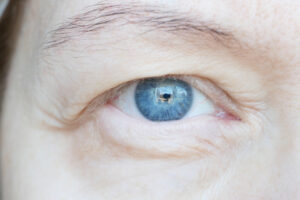When you look in the mirror, do you feel like you look constantly tired or appear older than your actual age? Drooping or sagging eyelids may be to blame!

One of the first places people begin to show their age is around their eyes. As you age, the delicate skin around the eyes begins to lose its natural resilience, becoming thinner, showing fine lines, and losing elasticity that causes it to sag or droop.
Age alone is not the only factor in how your eye ages. Other factors include heredity, exposure to sun over time, a history of smoking, stretching from swelling or weight gain, and wear from rubbing around the eye area.
The best way to restore the youth and vitality to droopy eyes is a blepharoplasty, which is also known as an eyelid lift. Keep reading to learn what happens during a blepharoplasty!
What is a Blepharoplasty?

Blepharoplasty is a cosmetic eye surgery that can lift and tighten the skin around your eyes, giving them a brighter, refreshed, and more youthful appearance. Blepharoplasty is one of the most requested cosmetic procedures in the US, mainly due to its impressive results.
This procedure produces subtle, yet noticeable improvements that can boost your self-confidence. A blepharoplasty can be performed on the upper eyelid, the lower eyelid, or both depending on the desired results.
An upper blepharoplasty is used on the upper eyelid to reduce and tighten loose skin that may be drooping, affecting the appearance of your eyes. It can also remove excess skin above the eyes, which may be impairing your vision, a condition known as ptosis.
A lower blepharoplasty can improve the appearance of bulging, bloated skin underneath the lower lid to create a flatter, smoother look. It can also help address loose skin sagging below the eyes as well as the fine wrinkles that appear with age.
What Can I Expect During the Blepharoplasty Procedure?
If you have elected to rejuvenate the appearance of your eyelids and restore their youthful appearance with a blepharoplasty procedure, here is a general overview of what to expect:
Consultation
Before undergoing the procedure, you should expect to have a full consultation with your eye surgeon. At this consultation, you and your surgeon will discuss your goals for the procedure.

Your eye surgeon will thoroughly evaluate your eyelids, as well as your overall facial structure, to determine the appropriate treatment plan and to give you realistic expectations about the results.
Anesthesia
The first step in a blepharoplasty procedure is the administration of anesthesia. Your eye doctor will numb the area that will be the focus of the procedure with local anesthesia to ensure you are comfortable.
The Procedure
During the procedure, your eye surgeon will make precise incisions along the natural creases of your eyelids. Your eye surgeon then carefully removes excess skin, fat, and muscles, depending on your individual treatment plan and desired results.
Closure
Once your eye surgeon has made the necessary adjustments to your eyelids, the incisions are closed with fine sutures. These sutures are carefully placed to minimize any visible scarring.
The positioning and use of the sutures will depend on whether you have an upper eyelid blepharoplasty or lower eyelid blepharoplasty.
What Happens After the Blepharoplasty Procedure?
Following the blepharoplasty procedure, you may be monitored in a recovery area for a short time. Before going home, your eyes will be covered with ointment and protective bandages.
After the procedure, you should allow yourself several days to rest. You may experience mild discomfort, swelling, bruising, or temporarily blurred vision, but these post-surgery symptoms should eventually subside on their own, usually within a few days or weeks.

Post-Operative Care
Your eye surgeon will provide you with detailed instructions on how to best take care of your eyes during your recovery. These instructions typically include applying cold compresses to reduce swelling, bruising, and discomfort; prescription ointments or eye drops; and avoiding activities that may strain your eyes, such as reading or watching a screen for extended periods of time.
Follow-up
Once your eyes have fully healed from the procedure, you will again meet with your eye surgeon to discuss the results. Your eye surgeon may suggest the use of injectable fillers or non-surgical laser treatment to enhance your surgical results.
With proper care, the rejuvenating results of a blepharoplasty procedure can last a decade or longer! Some of the ways that you can help maintain lasting results are by avoiding exposing your eye area to the sun with protective eyewear and sunscreen, staying hydrated to promote skin health, and eating a diet rich in vitamin C and proteins which specifically provide nourishment to your skin.
Because your eyes are often the first thing a person sees when they look at you, you want your eyes to look their best! If sagging skin, fine wrinkles, and puffy bags are affecting the youthful appearance of your eyes, a blepharoplasty procedure can restore their bright vitality!
Do you want to brighten the appearance of your eyes? Schedule a consultation today with one of the experienced eye surgeons at Nevada Eye Physicians in Henderson, NV, today!



